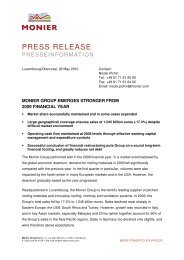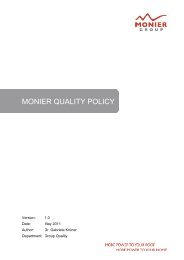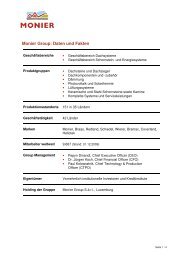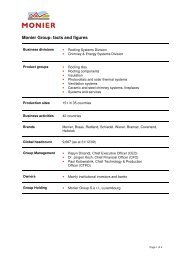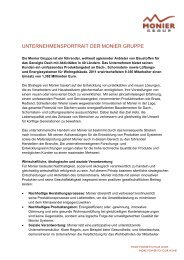ROOF-INTEGRATED PHOTOVOLTAICS
ROOF-INTEGRATED PHOTOVOLTAICS
ROOF-INTEGRATED PHOTOVOLTAICS
You also want an ePaper? Increase the reach of your titles
YUMPU automatically turns print PDFs into web optimized ePapers that Google loves.
Roof-integRated<br />
PhotovoltaicS<br />
Potentials and Challenges – From the<br />
Perspective of the Monier Group<br />
1
dachintegRieRte Pv<br />
Potenziale und Herausforderungen<br />
EXECUTIVE SUMMARY<br />
Roof-integrated photovoltaics<br />
The available data for the roof-integrated photovoltaics segment is very limited. Therefore, the Monier Group requested<br />
that EuPD Research, a market research company specialised in the photovoltaics industry, develop a market model<br />
to create greater transparency in the roof-integrated photovoltaics segment. In this context, more than 130 interviews<br />
with installers, manufacturers and distributors were conducted in Germany, Italy, France and the United Kingdom at the<br />
end of 2011. Statistical analysis along with the comparison of this primary data with validated existing data came to the<br />
following results:<br />
THE SEGMENT OF <strong>ROOF</strong>-<strong>INTEGRATED</strong> <strong>PHOTOVOLTAICS</strong> HAS BEEN CHARACTERISED TO DATE BY…<br />
• …a low degree of standardisation for product and system solutions,<br />
• …a presently limited market volume of about 300 MWp for 2012 in core European markets,<br />
• …a high degree of dependence on subsidies tailored to the building-integrated market.<br />
NEVERTHELESS, <strong>ROOF</strong>-<strong>INTEGRATED</strong> PHOTO-<br />
VOLTAICS HOLD GREAT PROMISE FOR THE<br />
FUTURE BECAUSE...<br />
• …they are becoming independent of subsidies,<br />
• …new requirements for building energy efficiency are<br />
stimulating the demand for sustainable products,<br />
• …they are turning PV into an energy-generating building<br />
material which meets this demand,<br />
• … the annual volume of building materials in the newbuild<br />
and renovation markets holds huge potential,<br />
• …products and installation processes are becoming<br />
more professional and are being standardised.<br />
THIS MAJOR POTENTIAL CAN ONLY BE<br />
UNLOCKED IF…<br />
•<br />
•<br />
•<br />
•<br />
…more knowledge about and acceptance of the benefits<br />
of roof-integrated PV is created among the different<br />
customer groups (e.g. homeowners, architects),<br />
…homeowners and architects play a greater role in<br />
the purchase decision process,<br />
… co-operation across various trades including installers<br />
is optimised,<br />
…the increased demands and expectations that home<br />
and building owners place on a multifunctional product<br />
are taken into consideration and met in the service<br />
package offered by suppliers.<br />
3
<strong>ROOF</strong>-<strong>INTEGRATED</strong> <strong>PHOTOVOLTAICS</strong><br />
Status Quo<br />
The segment of building-integrated photovoltaics (BIPV) can be subdivided into façade and roof integration (RIPV for<br />
Roof-Integrated PV). The major characteristic of these PV systems is their multi-functionality, as, in addition to power<br />
generation, they also offer weather and heat protection, fire protection, noise control as well as radiation protection<br />
(electromagnetic radiation). In the relevant European markets, roof-integrated systems have so far been much more<br />
common than façade-integrated systems.<br />
While the integration of PV into the roof is mainly confined to the small on-roof segment with installations of up to<br />
20 kWp, façade integration is usually used for prestigious projects in commercial or public buildings.<br />
Figure1: Types of building-integrated photovoltaics<br />
5
THE MARKET FOR <strong>ROOF</strong>-<strong>INTEGRATED</strong><br />
<strong>PHOTOVOLTAICS</strong><br />
RIPV-market volume – a quantity difficult to determine<br />
In contrast to the entire PV market, there is only very limited information on figures for the actual<br />
size of the roof-integrated photovoltaics market. Against this background, the Monier Group<br />
has developed a long-term RIPV market model with the objective of identifying relevant market<br />
drivers as well as the quantification of their influence on the RIPV market volume. By recurrent<br />
primary and secondary data collection, the number of data sets can be increased gradually in order<br />
to continuously refine the results of the analyses. Recent results from 2011 have shown an RIPV<br />
market volume of about 400 MWp in Europe’s most important PV markets of which well over<br />
50% were installed in the BIPV market in France.<br />
6<br />
Figure 2: RIPV market development 2009 – 2011 by country
Right now, RIPV is a segment dependent on subsidies<br />
The differences in market volume in various national markets clearly show<br />
that for now the RIPV market is almost exclusively dependent on subsidies.<br />
Without this support, there would be no market – at least none of any relevant<br />
size. Taking the Italian market as an example shows that the relationship<br />
to the “normal” feed-in-tariff is also of importance. The market can only be<br />
expected to grow when additional remuneration is able to compensate for<br />
higher cost levels.<br />
Figure 3: Correlation between RIPV subsidies premium and RIPV market<br />
share<br />
Analysed<br />
size ranges:<br />
0-4 kWp<br />
4-6 kWp<br />
6-10 kWp<br />
10-20 kWp<br />
7
NEW MARKET DRIVERS OPEN UP...<br />
Megatrend building efficiency – PV as part of the solution<br />
As residential buildings account for 15% of total CO 2 emissions, all new buildings<br />
must comply with the zero-energy guideline outlined in the European<br />
Directive on the Energy Performance of Buildings by 2012. This means homeowners<br />
must generate at least as much energy as they use during the year. In<br />
this context, photovoltaics will play a central role – after all, the possibilities<br />
for end consumers to generate their own electricity are limited.<br />
For a balanced account of a single-family house in Germany with an annual<br />
power consumption of 4,000 kWh, a PV system with a rated capacity of<br />
about 5 kWp is needed.<br />
Figure 4: Development of energy standards in Germany<br />
8
...NEW MARKET POTENTIAL FOR RIPV<br />
Roof-integrated versus on-roof – a cost comparison<br />
It can be expected that the use of<br />
photovoltaics in the new-build sector<br />
will rise in order to meet increased<br />
requirements for building efficiency.<br />
Here, the advantages of roofintegrated<br />
PV will come into play as it<br />
enables homeowners to combine<br />
the roofing of their home with the<br />
installation of a PV system.<br />
This is illustrated in the following<br />
figure. With a roof area of 150 m 2<br />
and a PV system with an installed<br />
capacity of 10 kWp, total costs for a<br />
roof-integrated photovoltaics solution<br />
are below those of the conventional<br />
BAPV solution. This is mainly<br />
due to lower planning expenses as<br />
well as other savings.<br />
Figure 5: Cost comparison RIPV vs. BAPV<br />
9
NEW MARKET DRIVERS OPEN UP...<br />
From “making money“ to “saving money” – PV has reached<br />
a new market cycle<br />
The positive development of photovoltaics in recent years is particularly related to the introduction of feed-in-tariffs<br />
(FiT) for solar power. FiTs guarantee the system owner a payment for the electricity they produce and feed into the<br />
grid for a specified period and yields high returns in many countries. This has proven a successful tool that, according<br />
to the REN 21 forum, is now applied in nearly 90 countries.<br />
But the widespread proliferation seems to be coming to an end and there is a clear indication that there will be only<br />
a few FiT programmes in the future. This is because, as a reaction to the significantly lower production costs, FiT payments<br />
have been reduced worldwide. As a consequence, FiTs are losing their appeal and are ultimately instigating their<br />
own abolishment.<br />
Figure 6: Index of feed-in-tariffs and PV prices in comparison (Germany)<br />
10
...NEW MARKET POTENTIAL FOR RIPV<br />
PV 2.0 on the rise – saving electricity costs as an incentive<br />
Developments show that the cost of electricity is rising steadily in numerous European countries.<br />
Sooner or later remuneration will be lower than the price of electricity. Germany can be seen as a<br />
good example (see chart). The data shows that the financial incentives for saving on energy costs<br />
in private households are increasing. On taking a PV system into operation in the second quarter<br />
of 2012, the energy saving potential through own consumption is higher than the remuneration<br />
paid for feeding electricity into the grid.<br />
The photovoltaic industry is facing a fundamental shift towards greater competitiveness which<br />
allows electricity to be produced at a lower cost than the electricity that comes out of the socket.<br />
This means that private owners of a PV system will have a higher interest in saving money than in<br />
making money in the future.<br />
Figure 7: A comparison of feed-in-tariffs and electricity prices (Germany)<br />
11
MARKET POTENTIAL FOR <strong>ROOF</strong>-<br />
<strong>INTEGRATED</strong> <strong>PHOTOVOLTAICS</strong><br />
The new-build segment – a sleeping giant<br />
Figure 8: RIPV market potential in Europe<br />
12<br />
European markets reveal significant potential for RIPV solutions. In Germany<br />
alone, the roof surface volume in the new-build and renovation markets<br />
reached 54 million m 2 in 2011. If this area had been fully equipped with photovoltaics,<br />
an annual market volume of about 8.6 GWp (assuming an average<br />
efficiency level of 16%) would have been reached. In reality, however, only a<br />
part of the roof surface is generally suitable for PV. Even when taking a conservative<br />
calculation using roof surfaces with a suitability degree of 25%, the<br />
cost advantages for roof-integrated solutions as previously shown sum up to<br />
a realistic market potential of 2.15 GWp per year. At an average system price<br />
of 2,000 euros per kWp, this results in a market volume of about 4.3 billion<br />
euros in Germany alone, according to calculations made by Monier. This is<br />
significantly higher than the current estimations for in-roof market volumes<br />
of about 40 MWp and 120 million euros. Under the given assumptions, also<br />
France, and to a lesser extent Italy and UK, appear to be very promising RIPV<br />
markets.
FUTURE MARKET DEVELOPMENT<br />
A market for companies with vision<br />
Figure 9: Market potential of RIPV 2012-2015<br />
Data from Monier shows that despite enormous market potential, a sharp<br />
increase in roof-integrated PV solutions in Europe is yet to come. The<br />
development stages and characteristics of various national markets are too<br />
different – and thus also the transformation process from a market dependent<br />
on subsidies to a market independent of subsidies. However, an increase in<br />
roof-integrated installations can already be noted, not least owing to developments<br />
in the German market where roof-integrated PV is currently leaving its<br />
niche in the PV market and becoming an approved building material.<br />
13
CHALLENGES<br />
Increased knowledge and acceptance creates rise in demand<br />
In order to unlock the market potential, both the end user and relevant distributors need to know more about the<br />
opportunities of roof-integrated PV systems. An architect who is not properly informed about RIPV will hardly be able<br />
to recommend an installation to a client. But knowledge alone is not enough. The technical expertise needed for planning<br />
and installation must be taught more intensely so that planners and installers can offer innovative solutions. More<br />
information is the key to more demand.<br />
Currently, consumers do not see roof-integrated photovoltaics as a cost-effective and aesthetically pleasing alternative<br />
to traditional roofing with an additional PV system. In the future, both architects as well as homeowners will have to<br />
play a greater role in the purchase decision process.<br />
Figure 10: Current significance of RIPV solutions in the new-build segment<br />
14
Electrical installation and roofing – two disciplines merge<br />
Roof-integrated PV combines the<br />
installation of a PV system with<br />
the construction of a roof. This<br />
places new demands on the trades<br />
involved, where the reality mostly<br />
looks like this: few roofers install PV<br />
systems – electricians do not build<br />
roofs. Close cooperation is rare. In<br />
the future, however, the trades involved<br />
will have to be closely linked<br />
to foster further distribution of roofintegrated<br />
PV systems. This might be<br />
achieved through optimised collaboration<br />
between the two professions,<br />
or by a merger of skills to form a<br />
“hybrid trade”.<br />
Figure 11: Trades installing RIPV solutions<br />
15
CHALLENGES<br />
New features create shift in demands<br />
With its protecting qualities against the elements, the roof is one of the most important functional parts of a building.<br />
At the same time, it is the least accessible part of the house. Continuous professional care and maintenance is<br />
therefore essential – also for roofs featuring photovoltaic systems. Manufacturers and installers are thus responsible for<br />
providing customers with a warranty and service package that clearly defines their rights and obligations and provides<br />
the customer with a guarantee comparable to that offered for traditional roofs. A look at the usual guarantee on material<br />
shows that there is room for improvement: while PV modules usually have a guarantee of 10 years, roof tiles have<br />
a guarantee of 30 years.<br />
Figure 12: Significance of product and service features that drive sales<br />
16
THE MONIER GROUP<br />
Leading expertise in roofing<br />
The Monier Group is a leading global supplier of building materials for pitched<br />
roofs with operations in 40 countries. Based on decades of experience, the<br />
company offers its customers a wide range of products including roof, chimney,<br />
ventilation and residential energy systems. We are continuously developing<br />
pioneering innovations for sustainable building, such as roof-integrated<br />
solar systems. That way, the Monier Group utilises the full potential of roofs<br />
in the interest of sustainability – for the benefit of its customers as well as<br />
today’s and future generations. In 2011, 9,350 employees generated revenues<br />
of 1.392 billion euros. For more information, please visit: www.monier.com<br />
Business line Monier Solar Roof Systems<br />
Monier offers a comprehensive portfolio of high-quality solar products along with a wide range of important accessories.<br />
Together, they create safe and reliable solar systems. For the development of its solar systems, the Monier Group has<br />
formed close partnerships with established module manufacturers and other suppliers and uses these products to develop<br />
and offer high-quality and competitive PV and solar thermal systems. The solar portfolio consists of the following:<br />
<strong>PHOTOVOLTAICS</strong>:<br />
Roof-integrated PV systems, PV roof tiles and modules, in-roof and on-roof fixings as well as accessories and inverters.<br />
SOLAR THERMAL:<br />
In-roof and on-roof thermal collectors, buffer storage and systems to heat drinking water and support heating systems,<br />
in-roof and on-roof fixings as well as accessories.<br />
The portfolio is tailored to the specific needs of each market. Monier is marketing its solar systems in various countries<br />
under its established product brands, e.g. Braas in Germany and Poland, Redland in the United Kingdom, Monier in<br />
France, Benelux as well as in Scandinavia, Wierer in Italy and Bramac in southeast Europe, as well as other brands and<br />
countries.<br />
17
PICTURE INDEX<br />
fotolia.de | Sonne am Himmel © Reicher Large cover image<br />
© Monier Group Cover, p.3, p.4, p.5.1-5.3, p.15, p.17<br />
© Florian Schmidt p.5.4<br />
© Eva Francis Benz p.6.1, p.7, p.12<br />
fotolia.de | Solarhochhaus © danielschoenen p.5.5<br />
fotolia.de | Bilanzierung © Stauke p.6.2<br />
fotolia.de | Energie sparen © Gina Sanders p.8<br />
fotolia.de | Hangglider © Galyna Andrushko p.13<br />
© MONIER GROUP 2012<br />
This document and all of its contents (texts, figures,<br />
pictures and layout) are protected by German copyright<br />
law. All rights for contents, diagrams and illustrations contained<br />
in this publication are protected by copyright and<br />
reserved for the Monier Group. Unauthorized use of this<br />
publication, including duplication, distribution, reproduction,<br />
translation, and processing in electronic systems is<br />
punishable by law.<br />
18<br />
AUTHOR:<br />
Monier Group/EuPD Research/HRCG<br />
CONTACT MONIER GROUP:<br />
Group Communications<br />
press.group@monier.com<br />
Business line Monier Solar Roof Systems,<br />
Jens Milnikel<br />
jens.milnikel@monier.com
MonieR group Services gmbh, Frankfurter Landstrasse 2-4, 61440 Oberursel, Deutschland<br />
t +49 61 71 61 0 06 f +49 61 71 61 23 00 www.monier.com<br />
20






